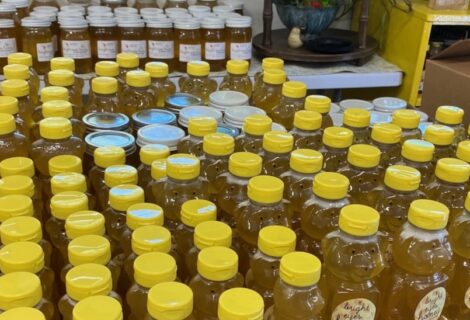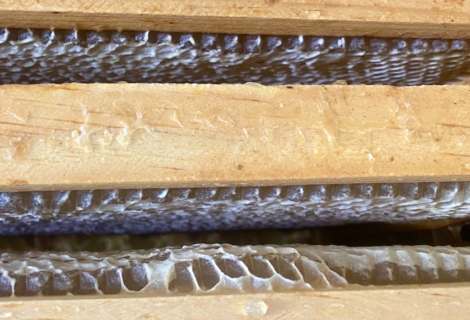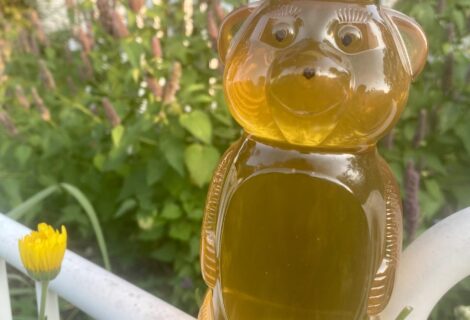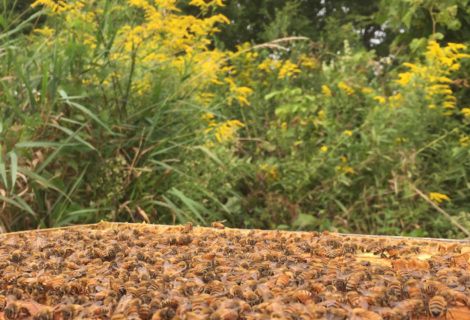The Primacy of Pollen

Worker with orange load moves under hive entrance while a sister comes in for a landing with a yellow load.

And touchdown! Her wings are still beating, but she has quite the self-satisfied look about that performance.
Honey bees are well designed for collecting these pollen “pellets” on both of their hind legs. They have a series of anatomical features that allow them to collect the pollen from various flowers they visit and transport in the fashion seen in these pictures. As it visits flowers, the bee continuously transfers pollen onto the hairs of its hind legs. Then while the bee is flying, the two hind legs rub against each other, forcing the pollen grains down the leg and into the “pollen press” on the inside of the opposing leg. They have a feature called the “pollen rake” that helps to do this. The new pollen grains, which the bee has moistened with nectar, get compacted by the “press” and pushed into the pellet held in the pollen basket on the outside of the hind leg – all handled automatically by the mechanics of flight motion. There is actually a special long hair protruding from the pollen basket area of the hind leg that runs through the pollen pellet and anchors it there. If you’ll notice in some of these pictures though, they are taking in so much pollen that once in a while a piece of the pellet breaks off as they enter the hive and it is laying on the bottom board.
Inside the hive, the bee will remove the pellets with its middle legs and they are placed in cells. I snapped the following picture a few minutes later (Sony camera this time) when inspecting a frame that contained a variety of different types of pollen. When you see this in the colony, it can be a beautiful mosaic. After the worker who carried in the pollen unloads, other worker bees (like those shown here) treat the pollen with a phytocidal acid to prevent germination, and pack the pellets into the cells, followed by a glaze of honey over the top to preserve them for later use. Apparently, they add some additional enzymes and beneficial bacteria in the process so that it gets a head-start on digestion when fed to the young. It has a high content of histamine and vitamin K. If only we had an optimized ‘canning’ system like this.
Pollen is supremely important to the colony. It is their source of protein and lipids. It also contains sterols necessary for their metabolism, and other constituents besides. Without pollen, they cannot develop or reproduce. Think of nectar as “fuel” – it is used for transportation and for heating the colony. Processed pollen though, is ‘real food’, and its digestion by nurse bees allows their glands to produce the “brood food” that are feed to young larvae before they can ingest regular pollen and honey.
At the most recent bee club meeting in Rochester, Dr. Marla Spivak from the University of Minnesota Bee Lab commented on an interesting finding from one the recent research programs. She said that all other things being equal (nectar availability, mite loads, weather, farming practices and pesticides, colony size & stores, even stored pollen, etc.), the biggest predictor of whether a colony would survive the winter was how much and how diverse the daily intake of pollen was by the hive. These were general observations and not something objectively measured, but it seems that healthy colonies find and transport back lots of diverse pollen on a consistent basis. Food for thought and something I will try to keep more of an eye on.
Much of the above information was sourced from:
“The Biology of the Honey Bee” – Mark L. Winston, Harvard University Press, 1987.











Recent Comments